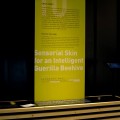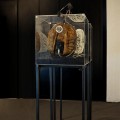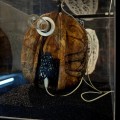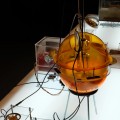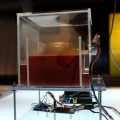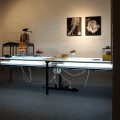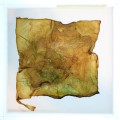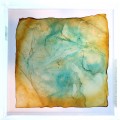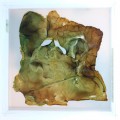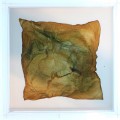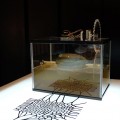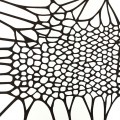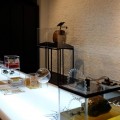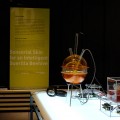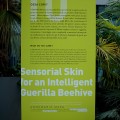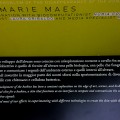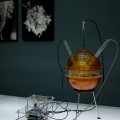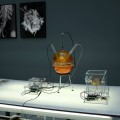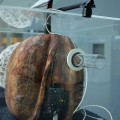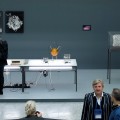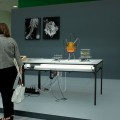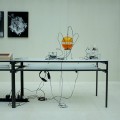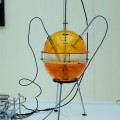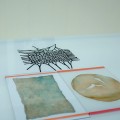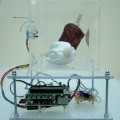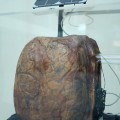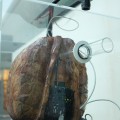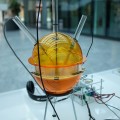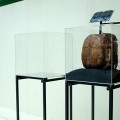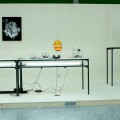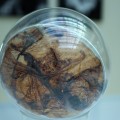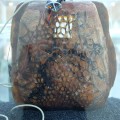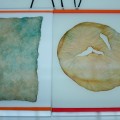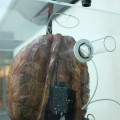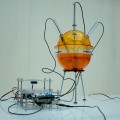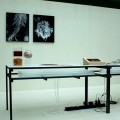The question that has haunted philosophers, politicians and poets since time immemorial is: how can we build a fair world? What would it look like? And what would it involve?
Equality of opportunity? Of income? Access to technology? Education for all? Or is it all simply down to geography or chance – and is it all totally out of our control? Are the words of the Universal Declaration as self-evident as they sound in the way in which society works?
Inspired by the recent report on Fairness by the Joint Research Centre, the European’ Commission’s leading scientific research and policy-supporting institution, the second Resonances exhibition, Fair/Fear collides scientific research with artistic investigation to provoke conversation and inspire answers.
Looking at fairness from the perspective of Nature, Society, Economics, Science and the Cosmos, artists and scientists from ten different countries in Europe work together to engage with the concept of fairness. They also ask you what would you feel if we didn’t try to make the world a fair place? Would the world become a Fear Fair – a place ruled by the chaos of fear, with anger lurking to lash out, rather than a place with a sense of justice, striving for a sense of order and equality?
This second SciArt Fair in the JCR Resonances exhibition series, will take place at the Museum for Science and Technology in Milano, from 21 September – 22 October 2017, premiering first at the JRC itself on 13-15 September 2017 on its site in Ispra. The Resonances Festival combines scientific and artistic research with policy-making to reach out to society and create resonances in society. Learning to be more real (with science) to become more true (with art), to be more present (in society).
https://ec.europa.eu/jrc/en/event/exhibition/resonances-ii-exhibition-fairfear
Belgian artist AnneMarie Maes presents her ongoing (research) project The Intelligent Guerilla Beehive, collaborating with biologist/computer scientist Núria Condé Pueyo (Complex Systems, Universitat Pompeu Fabra Barcelona), and with microbiologist Laura Gribaldo and environmental engineer Paulo Rosa (JRCIspra).
The Intelligent Guerilla Beehive is a shelter for swarming bee colonies, prototyped out of organic materials and powered by green energy. It is a bio-technological sensing device to measure the health of the environment as well as to monitor the wellbeing of bee colony living inside. Bacteria -living in a biofilm on the outer skin of the beehive- send out warnings by adapting their colour to different degrees of environmental contamination. Bacteria living on the inner side of the beehive’s skin support the bees in their struggle against the Varroa mite.
Sensorial Skin for an Intelligent Guerilla Beehive – presentation at Resonances II festival in Milano, It. (Must Museum Leonardo da Vinci)
Sensorial Skin for an Intelligent Guerilla Beehive – presentation at JRC/Ispra (It.)
Sensorial Skin for an Intelligent Guerilla Beehive – build up installation at JRC/Ispra (It.)
More background information, experiments and processes in the lab notebook on my wiki:
http://urbanbeelab.okno.be/doku.php
about the project
‘The Intelligent Guerilla Beehive is a speculative research project that combines in a radical way smart materials, biomimetic forms and biotechnology. It is inspired by the intelligence, complexity and self-organisation of bee colonies as Super Organisms.
‘Sensorial Skin for an Intelligent Guerilla Beehive’ is a bio-art installation on the edge of art and science. It evokes issues of sustainability and biodiversity, giving viewers an artistic experience of my ongoing research related to the disappearance of the honeybee.
Bees are bio-indicators. They reflect the health of their surrounding ecosystem as well as the cumulative effects of different pollutants. But in many industrialized nations bee colonies are now threatened. Pesticides and parasites are among the main factors, but equally worrisome is air pollution and the compromised state of the bees’ foraging fields. To tacle the unfairness against honeybees, I developped a radically new beehive: The Intelligent Guerilla Beehive. This mobile shelter for swarming honeybees is designed for urban environments. It supports the bee colonies in their pollination tasks, and as result indemnifies the biodiversity of their foraging fields.
The research and development of the device have also been a starting point for exploring possible futures through artistic experiments on materials science and biotechnology. The Sensorial Skin – the outer membrane of the Intelligent Guerilla Beehive – is a smart fabric grown by Acetobacter bacteria and yeast cells. It is augmented with a mix of organic and electronic elements for sensing and actuating, for computation and for communication. Lactobacillus plantarum bacteria living in a biofilm on the upper cellulose skin act as biosensors. When they sense a specific degree of pollution, they are changing colors and making patterns that reflect the environmental threats. The double-sided skin, wrapped at one side in a bacterial biofilm and at the other side covered by a pattern of porous stomata, is also giving room to beneficial micro-organisms to attack the bees’ natural enemy the Varroa destructor mite.
Most of the experiments were run in my ‘Laboratory for Form and Matter’ where I work with a range of biotic and abiotic elements. I view my lab as an open environment for experimentation, a space for contradiction, criticism and evaluation. I combine organic components such as vegetal matter, propolis and chitine, with living systems such as fungi and bacteria. My micro-organisms grow biofabrics and I research how these membranes can be enhanced and made useful through embedded electronics and how more sensorial qualities can be implemented in these membranes via living technology. Navigating between blueprint and ‘Proof of Concept’, the resulting prototype can be classified as ‘Future Archaeology’: a fragment of a Forgotten World as well as a fragment of a World To Come.’
bio
AnneMarie Maes is an artist and a researcher. Her art meanders on the edge of biology, ecology and technology. Her research practice combines art and science with a strong interest for DIY technologies. She works with a range of biological, digital and traditional media, including live organisms.
Her artistic research is materialized in techno-organic objects that are inspired by factual/fictional stories; in artifacts that are a combination of digital fabrication and craftsmanship; in installations that reflect both the problem and the (possible) solution, in multispecies collaborations, in polymorphic forms and models created by eco-data. In her Laboratory for Form and Matter she studies the processes by which Nature creates form: the creation of honeycombs, how bees self-organize into swarms, how plants grow and form geometric patterns, how bacteria and yeast cells collectively create material surfaces forming biofabrics. She observes and analyzes these processes, isolates them or causes them to appear in artificial conditions. She creates art works from this artistic research in many different media: installations and sculptures, video, audio, photographs and objects.
Anne Marie Maes is a founding artist and director of several non-profit art collectives as Looking Glass, So-on and Okno. She has for decades been a recognized leader pioneering art/science projects in Belgium, using highly original ways to bring out hidden structures in nature by constructing original technological methods to probe the living world and by translating that in artistic creations.
She has a strong international profile, having exhibited (amongst others) at Bozar in Brussels, Koç University Gallery in Istanbul, Borges Center in Buenos Aires, Arsenals Museum in Riga, Skolska Gallery in Prague, the Institute of Evolutionary Biology in Barcelona, the Designmuseum in Mons, the Wissenschaftskolleg in Berlin, Museum de Domeinen in Sittard, Grey Area Gallery in Korcula, the OK Center for Contemporary Art in Linz (Ars Electronica), the Science and Technology museum in Milano.
In 2017 she was awarded a Honorary Mention in the Hybrid Art category at Ars Electronica, for the Intelligent Guerilla Beehive project.
relating to Fairness …
‘My work is a tight coupling between research and art. It meanders on the edge of biology, ecology and technology. My artistic research is materialized in techno-organic objects that are inspired by factual/fictional stories; in artifacts that are a combination of digital fabrication and craftsmanship; in installations that reflect both the problem and the (possible) solution, in multispecies collaborations, in polymorphic forms and models created by eco-data.
I study the processes by which Nature creates form: How bees create honeycombs, how they self-organize into swarms, how plants grow and form geometric patterns, how bacteria and yeast cells collectively create material surfaces forming biofabrics. I observe and analyze these processes, isolate them or causes them to appear in artificial conditions. I create art works from this artistic research in many different media: installations and sculptures, video, audio, photographs and objects. These art works often go beyond the pure esthetic experience of remarkable structures, even if the sense of beauty is always there.
My bio-art project – Sensorial Skin for a Guerilla Beehive – tackles a new challenging application domain where a collaboration between human and non-human actors (bees, bacteria, other micro-organisms) is necessary to maintain the resilience of the system. We reached the end of the anthropocene. We have to work on an ecosystem where all actors collaborate to keep up the resilience of the system. As artists, scientists, beekeepers, makers and thinkers, we collaborate with plants, insects and micro-organisms. With materials collected by the bees and with the help of bacteria the design of the Intelligent Guerilla Beehive comes into shape. In return for this support, the bees provide us with massive amounts of data and loads of information on the ecosystem that is hosting the Guerilla Beehive.
This project is driven by the intelligence, complexity and self-organisation of the Super Organism, it is a development together with ‘the other organism’. The collaboration with Nature should lead to a more diverse and thus more resilient system, post human and post anthropocentrism.’

